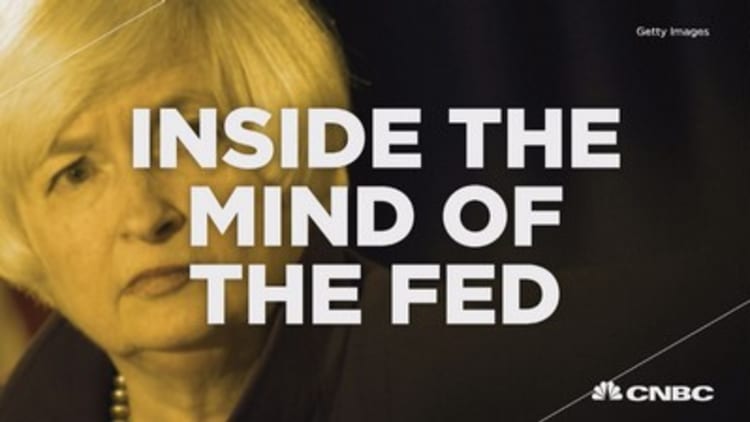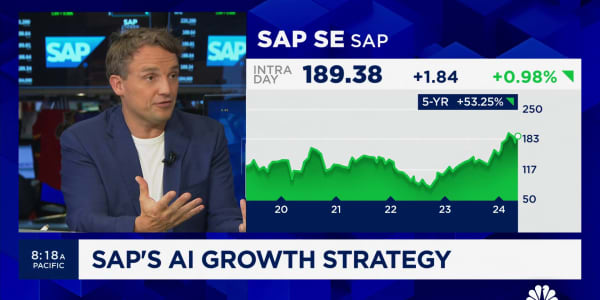
Stock market players are toying with becoming their own worst enemies, buying themselves square into the teeth of an interest rate increase.
The post-Labor Day rally Tuesday was good news inasmuch as it helped offset a horrible start to September, which in itself added to a brutal August that saw the major indexes drop more than 6 percent.
But timing is everything when it comes to market movements, and if the momentum bleeds into next week, it could be just the thing that gives the Federal Reserve impetus to hike rates for the first time in more than nine years.
"If a higher stock market is the Fed's implied third mandate, then are we rallying into a rate hike next week?" Peter Boockvar, chief market analyst at The Lindsey Group, wondered in a note to clients Wednesday morning.
The question is a critical one. Most surveys of Wall Street pros—economists and strategists—indicate the U.S. central bank is poised to make a move at the Federal Open Market Committee's Sept. 16-17 meeting. Futures markets, though, say otherwise, with the CME's FedWatch tracker still indicating just a 24 percent chance of a quarter-point increase.
More like 'market dependent'
Indeed, the odds in many ways seem against it.
Former White House economic adviser Larry Summers put up a blog post Wednesday arguing that the case for a rate hike is even weaker now than it was two weeks ago. Deutsche Bank economist Joseph LaVorgna and his team also put out a note late Wednesday morning outlining "seven reasons why the Fed won't hike rates this month."
"I understand the argument that zero rates are a sign of pathology and the economy is no longer diseased so policymakers have to increase rates," Summers wrote. "The problem is that the case for hitting the brakes in an economy with sub-target inflation, employment and output is not there; regardless of whether the brakes are to going to be pressed hard or softly, singly or multiple times."
For months, Fed Chair Janet Yellen and her counterparts have insisted that a decision about rate hiking will be "data dependent." However, it's not just economic data that gets the Fed's focus.
Equity markets have rallied and bond yields have stayed low since the Fed began the dual actions of quantitative easing and near-zero interest rates back in 2008, during the Great Recession and the financial crisis. Each time the Fed has even threatened to take its foot off the policy accelerator, markets have recoiled with stock selloffs and "taper tantrums" like the one that happened after former Chairman Ben Bernanke indicated in 2013 that QE could end soon.
Stocks have stumbled since the third version of QE ended in October, trading slightly lower since then. How the market would handle losing the second leg of the Fed's ultra-easy policy is tough to say.
"The cumulative improvement in the economy over the past few years means that it is almost impossible to justify interest rates still being at near-zero," Paul Ashworth, chief U.S. economist at Capital Economics, said in a note. "Nevertheless, a number of Fed officials clearly want to use the recent volatility in financial markets as a reason to delay the first rate hike yet again."
Volatility has been the hallmark of the late-summer market, with wild swings in both directions.
Early Wednesday trading indicated another leg higher, after Asian markets teed up a rally during the U.S. overnight hours. However, the move higher quickly ran out of steam, with markets pulling back later in the morning though with no particular catalyst for the cool off.
The Fed, though, has plenty to digest ahead of its most pivotal meeting in years. For years the basic data have pointed to an economy well out of the crisis that spurred the extreme Fed policy moves, which ultimately exploded its balance sheet to $4.5 trillion.
Most recently, Friday's payrolls report, while a bit below Wall Street expectations, continued to show growth in a labor market that has added 247,000 jobs a month over the past year. Wednesday's Job Openings and Labor Turnover Report, or JOLTS, survey showed a big gain in job openings, another positive sign.
"Will today's blowout job openings number tilt the scales at all for next week's Fed decision?" JPMorgan economist Michael Feroli asked in a note. "One might think it should matter for a 'data dependent' Fed, but with data dependency apparently now extended to how equities trade it is not certain how this report will shade their thinking."
Read MoreFed closer to 'monetary Y2K,' but not there yet
Despite the payroll gains, inflation remains muted, at least by the Fed's favorite gauges. Hourly earnings indicated an annualized gain of 2.2 percent, which approaches the Fed's inflation target, but the move "likely reflected a boost from calendar quirks than a fundamental movement," Goldman Sachs economists Zach Pandl and Alec Phillips said in a report.
Goldman is holding to its out-of-consensus forecast that the Fed will wait until December to hike, while Capital, which has been calling for a rate hike for much of the year, now believes September's odds are "close to 50-50."
Capital's Ashworth had a few more interesting Fed observations: that the central bank's policy rate is the same at 5.1 percent unemployment as it was at 10 percent, and that models following the "Taylor Rule," which seeks to model proper rates against economic growth, put the Fed's rate above 3 percent.
"Regardless of the exact timing of the first rate hike, we anticipate that rising wage growth and core inflation will force the Fed to raise rates much more aggressively next year than the markets currently expect," Ashworth said.
Boockvar said elevated levels of market pessimism remain a contrarian positive indicator for near-term stock movement. However, he believes the rising-rate environment is posing dangers to the longer term.
"I still believe that the odds are greater than 50% that the bear market has begun," he said. "The extent of the current rally and whether it 'fails' or not will be a great test of that belief."






